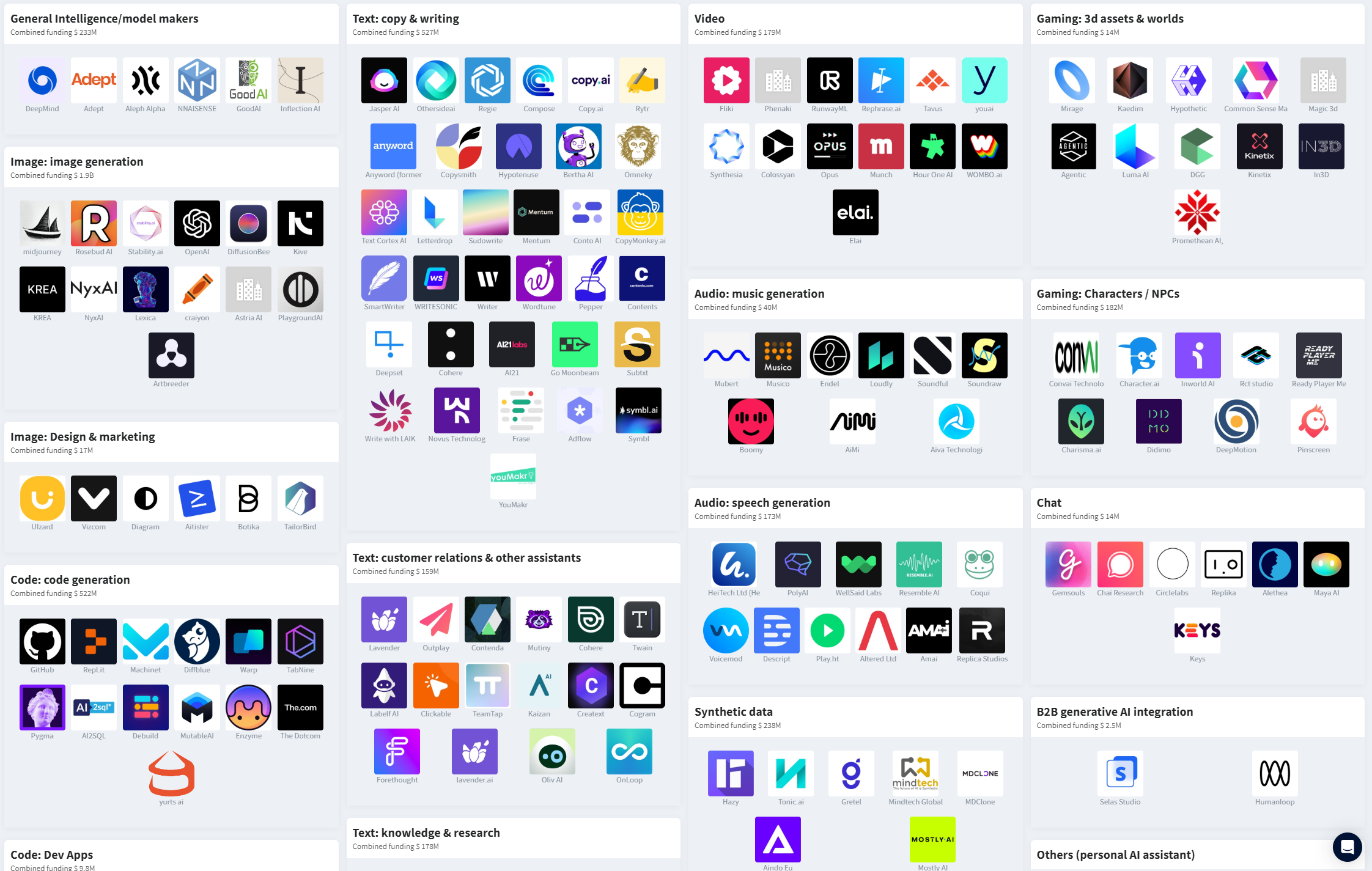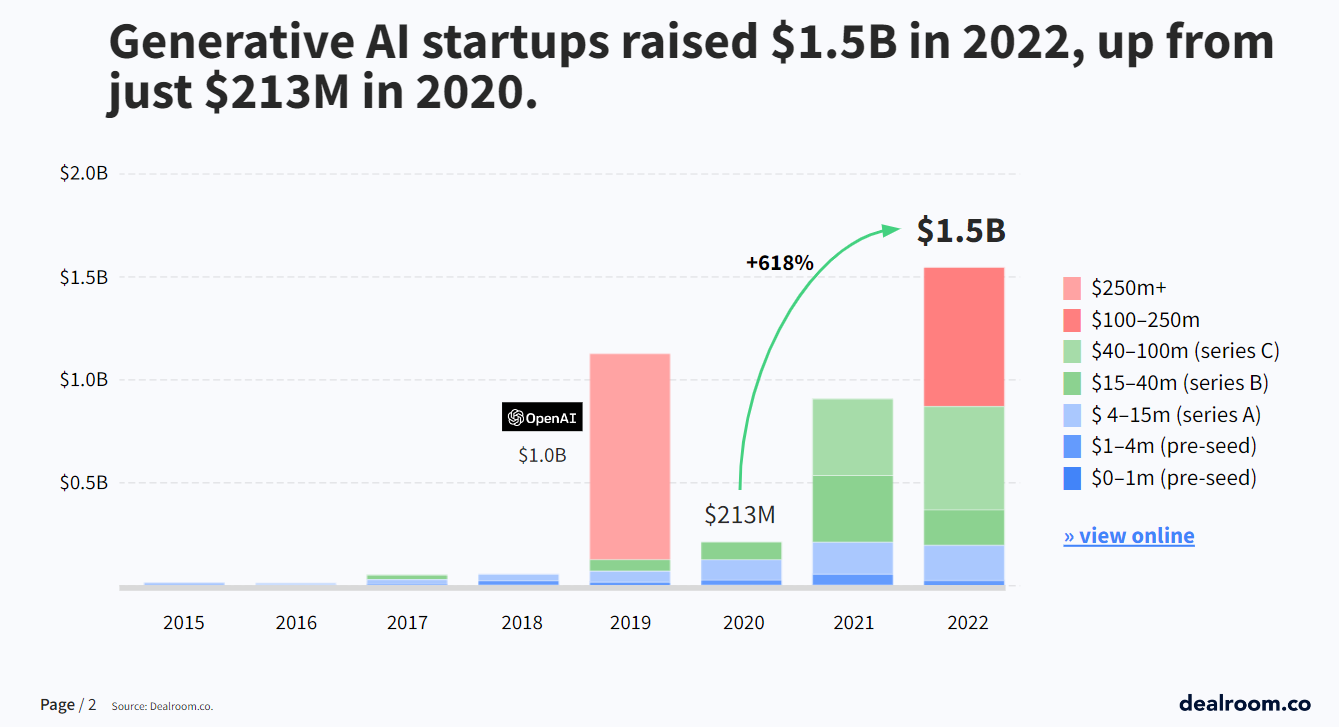Is Generative AI outpacing human creativity?

Generative AI promises to kick off a new era of creativity. Is the hype real?
AI, a.k.a machine learning solutions, are ushering in a new generation of products and services. However, so far AI had found its application mostly in data-driven and analytical workflows. Creativity and ideation was considered far away from the capabilities of artificial intelligence.
This changed with the recent emergence of Generative AI (GenAI) and programs such as StableDiffusion and ChatGPT. GenAI is an emerging frontier of AI models which are trained on large data sets of content media (text, images, audio, video) to create new text, audio, images and more.
We’ve mapped over 200+ companies in the GenAI space. 👈

Promises and challenges of GenAI
GenAI is quickly becoming comparable or, argued by some, better than the average human creation, along with also being faster and cheaper. This opens applications in a wide range of industries such as marketing, advertising and sales, media, gaming, graphic design, product design, law, coding, architecture and more.
What does GenAI mean for the value of human creation? And, what happens to creative industries prone to disruption?
GenAI might completely replace certain functions, while only enhancing human creative work in others. Besides writing blog posts, GenAI could dramatically bring down the cost of media that is usually prohibitively expensive such as movies or video games.
This might drop the price of content creation to near zero, but being able to use GenAI might also become a marketable skill – which opens up opportunities and ethical challenges.
Along with the ethical concerns, GenAI may face legal challenges. The models are often trained on copyrighted material posing the question of IP and revenue sharing to the original creators.
GenAI also faces the “fluent b.s.” problem generating responses that most resemble an answer to your question/prompt, but is by no means true (e.g. arguing that an abacus is faster than a computer, or that a falcon is a marine mammal).
In response, Google recently rolled out their Helpful Content Update to detect low-quality content created for SEO and/or by GenAI. Similar steps were taken by Getty Images and Stackoverflow.
Large Language Models (LLMs)
Most GenAI is built on Large Language Models (LLMs), huge neural networks based on the Transformer’s architecture.
A few key players (OpenAI, Stability etc.) research and train the foundational models on top of which a wide array of companies build their business models, like how Jasper AI is building on top of GPT-3. Differentiated, proprietary data sets and unique access to scalable, real-time data allows a company to build a long-term competitive moat around its technology.
To get a feel of the size, GPT3 by OpenAI was trained on 175 billion parameters, while the upcoming GPT4 should reach 100 trillion parameters, 600 times more.
Yet, there are still some lingering ethical concerns for LLMs. Lensa AI is reported to have generated $1B in one day after introducing its character generation feature, but many users have complained about its racially biased and sexist depictions. Other LLMs are facing similar concerns.
VC investment trends for GenAI
GenAI startups raised $1.5B in 2022, up from just $213M in 2020.
VCs have been pouring into the segments with massive funding which raised $1.5B in 2022, up from just $213M in 2020. and the first megarounds raised by Inflection AI, Cohere, Jasper AI, Stability AI and Glean. Many top-tier investors are becoming active in the space including Sequoia, Index Ventures, Tiger Global, Lightspeed Ventures, Coatue Management, and Bessemer Venture Partners.
Even corporate investors are entering the space. Microsoft already invested $1B in OpenAI back in 2019, and Slack participated in Glean’s unicorn round this year. GenAI startups are now valued at a total of $21B with its first unicorn being OpenAI, Jasper AI, Glean and Stability AI.
With the growing influx of venture capital, the value of the space grew to a total of $21B in 2022. This year also gave rise to the first unicorns next to OpenAI, most prominently seen with Jasper AI which reached this milestone a mere 18 months after being founded.
With many companies and solutions building on foundational models from OpenAI, Stability and others, it remains to be seen if these valuations hold. It is still unclear what market structure will emerge, but VCs are betting on what they consider the future winners.

It’s clear: GenAI is here to stay. ChatGPT has reached 1 million users in 5 days, a feat that took Twitter 24, LinkedIn 17 and even Instagram 2.5 months. Research in AI has skyrocketed in recent years and will continue to give rise to more advanced systems.
For more on the GenAI startup space, access our full briefing below.
Report - A New Frontier: Generative AI in 2022
This post was *not* written with GPT. Real humans at work (Lorenzo & Felix)
Additional resources:
On the generative wave – Exponential View
Introducing ChatGPT – Cassie Kozyrkov
Interested?
